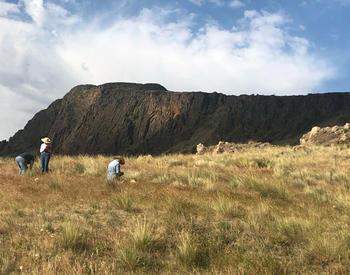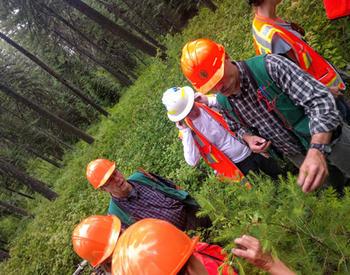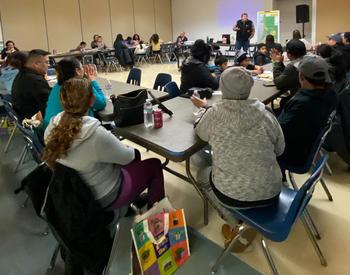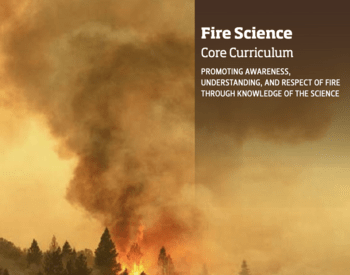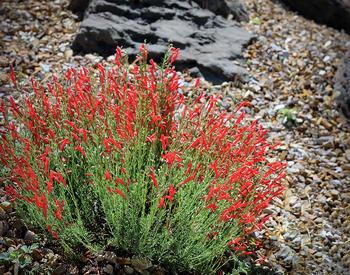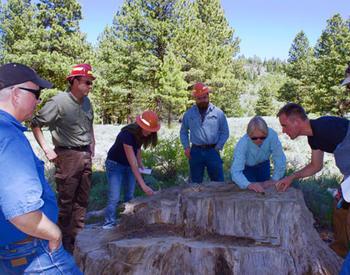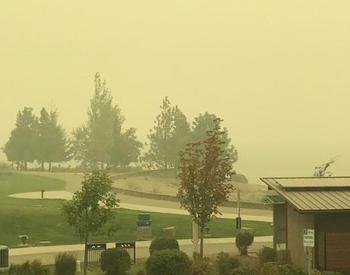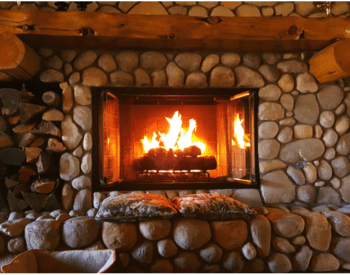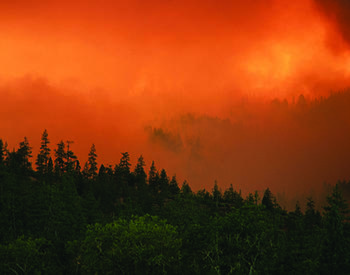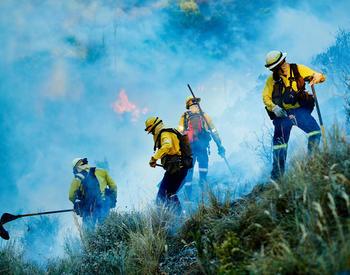Transcript
Andony Melathopoulos: [00:00:00] I know it has been a very difficult year for many of you. And for listeners in California, Oregon, and Washington, it was particularly difficult because of the wildfires that swept through the region in late summer. And I've had a lot of questions a an Extension Agent here in Oregon about the bees that were in the path of those fires. And that made me think it was time to reach out to Jim Cane, who is no stranger to the show, he's been on multiple times. He's a retired scientist from the USDA Bee Lab in Logan, Utah. He studied the biology of bees and fire extensively in work as you're going to hear in this episode in sagebrush steppe systems on the East side of the Cascades, in the Great Basin.
[00:00:50] But, in this episode he's going to give us a levalland of what we might expect to happen to some of our bee communities in the path of the fire, but also what to [00:01:00] expect in the coming years as successional plant communities start to step in and we start to see changes in those landscapes. Dr. Cane also has some suggestions after the break on restoration decisions for dealing with burned landscapes. So without further ado, I'm pleased to bring back Dr. Jim Cane this week on PolliNation.
[00:01:26] Welcome back to PolliNation, Jim.
[00:01:28] Jim Cane: [00:01:28] Thank you, Andony. I like to talk with you, as always.
[00:01:32] Andony Melathopoulos: [00:01:32] We had some correspondence during the summer, as you remember, this was a terrible, terrible fire year in California, Oregon and in Washington. And at the time I was getting a lot of questions, through "Ask an Expert" and other Extension portals where people were concerned about bees and fires. When I went through the literature and looked for examples of people who had worked on the actual biology of bees and fires, you were the [00:02:00] person at the top of the list. Tell me how you got interested in this question of fire disturbance and bee communities.
[00:02:07] Jim Cane: [00:02:07] Well, it stemmed from actually an interest on the part of the Bureau of Land Management and the largest research project that they supported, especially through Peggy Orwell a couple of decades ago - was to try to do a better job of rehabilitating fire site burned areas in the sagebrush steppe between the Eastern Cascades and over here in Utah. Where as you recollect, there were some fire years with dry lightning storms that lit off hundreds of thousands of acres. And their reseeding efforts and the like, weren't being that successful. And they were very simplistic they were mostly sagebrush and a few grass species, some of them exotic grasses. And they wanted to put [00:03:00] back more of a plant community.
[00:03:01] While I was at this thing with pollination of various promising wildflower species that are widespread out there and use extensively by bees, which I documented I became quite worried that, "wow, when fire goes to sagebrush steppe, it looks like a lunar landscape afterwards." Not a shrub, not a stick, nothing. It's just bare dirt and a little bit of ash. And so I became deeply concerned that, "wow, are bees being consumed by this? And if not, if they're surviving, what in the world are they going to use for the next generation?" So since many of these bees have one spring or early summer generation that live in the sagebrush steppe.
[00:03:44] So I did heating experiments thinking, well, maybe there's some susceptible life stages. It turns out it's not. Egg, larvae, pupae and adults all have the usual temperature sensitivity around 40 degrees - the temperature in which proteins [00:04:00] denature, but eggs are not more susceptible for instance. In addition, my graduate student and technician Byron Love did some very nice experimental work with access to a suite of dominance, perennial wildflowers that are herbaceous out there, the bees use it extensively. And found that while several of them are quite susceptible to fire because their apical buds are above the ground level. Most of them survived just fine with a August or September burn, which is when most of the fires pass through.
[00:04:36] And so we came to realize that, "oh, this isn't such a bad thing!" If the native flora was in good shape before the fire - because these fires in sagebrush steppe, the fuels aren't as great as your forest fires. And the resident time over the soil was quite limited, it doesn't heat the soil much. Most of the pollinators are ground nesters and everything comes back [00:05:00] the following year, except that the forbes now don't have all the water competition with sagebrush.
[00:05:06] So that's where my experience comes from. I've been learning a little bit more with fires in your West Coast forests working with Sara Galbraith and Jim Rivers on a large project down in the Douglas Complex fire. But I think there's things that we can predict in advance of what will happen to bee in these fires. And some are going to be quite different because the fuel loads, the residence time, the intensity of the fire is quite different in the tourfor.
[00:05:39] Andony Melathopoulos: [00:05:39] Let's come back to just what happens. I liked the way that you laid the problem out because there are connected, and related issues. And the first one is just surviving the fire. There's a bee community that's humming around doing all the work and living its life. And then a fire comes [00:06:00] through and I guess primarily, if we were to consider two life history patterns, one is stem nesting, and one is ground nesting. I would imagine if you're a stem nester, you probably won't survive. But what do we know about the ground nesting bees and their capacity? I mean, you talked about that the stages are equally vulnerable, but I imagine there's some buffering capacity of being a few inches into the ground.
[00:06:28] Jim Cane: [00:06:28] That is exactly right. For the twig nesters I think they're toast, I don't see any way around that. They're lucky if there's an island of unburned vegetation in the midst of a fire perimeter, otherwise they're toast. So your little small carpenter bee, genus Ceratina that some of your listeners will know would be one familiar example. For ground nesters, Jack Neff, and I did a large survey of cell depth of ground nesting bees with everything we could find in the [00:07:00] literature. With Jack being the more encyclopedic of the two of us, he came up with 400 and some odd reports of cell depth, and it averages out around 12 or 15 inches underground for the average bee. But the range, the deepest bees, which are incredible, are three or four meters down a solitary bee digging that tunnel.
[00:07:21] And the shallowest one happened to be bees of the genus, some of the Megachilids to which the blue orchard bee and the alfalfa leaf cutter bee along. Most people don't appreciate it, but a number of those nest in the ground, most quite shallowly. We've dug an unnamed species of Osmia over here in Easter Nevada and its little nest cells were tucked into grass tufts. I've worked at another one in Wyoming who made its nest in dried up cow dung. Among the ground nester those would be the most susceptible, I presume. And [00:08:00] I think they fare okay with sagebrush steppe because the genus Osmia is one of the three dominant bee genera that we see at wildflower species after wildflower species out here. Huge number, huge diversity of them.
[00:08:17] Andony Melathopoulos: [00:08:17] Even if they nest shallowly, if you go back the next year, you see them show up again. Is that what you're saying?
[00:08:24] Jim Cane: [00:08:24] Yes! I had initially established and Byron Love came on to make this part of his PhD project. We did what we call a chronosequence since we couldn't light off fires and we couldn't wait for 20 years for fires to age. We took a series of big fires of different ages and sampled them over a handful of years, where there were bee faunas at least a half mile inside the fire perimeter. So these are all big fires - to make sure that they were resident bees, [00:09:00] not commuters from outside the edge. And then matching them to outside the fires, we don't know what the flora was like inside the fire because we weren't there to observe.
[00:09:10] And what we found is even in the year after burning, a number of these Osmia are still present and working their particular wildflowers. We walked one last year, the Valley Fire, very remote fire in Nevada and there were all the bees, present and accounted for. So from that perspective, revegetation efforts, especially if one's using range drills to put in seed and tearing up the surface are actually going to be detrimental to both those shallow nesting bees and to the surviving wildflowers who apical meristems are near the surface, like biscuitroot for instance. So one has to know their vegetation a little bit in [00:10:00] order to accommodate where the effort is needed.
[00:10:04] Andony Melathopoulos: [00:10:04] Can I just pick up on that one point? A current practice after the fire is to get the seed in and to revegetate is to go in and disturb the soil, which may have an effect on some of these shallow nesting bees. As opposed to if it was just left on its own, it probably would revegetate anyways, is that what you were getting at?
[00:10:36] Jim Cane: [00:10:36] Yeah. And mind you, there are for sure cheatgrass. So the flammable Eurasian grass that is a potent invasive in the sagebrush steppe. It's hiding out in places and in and amongst the sagebrush. And so when that surface is cleared, it's an annual grass and it can germinate quickly. [00:11:00] And there are times in which there's a transition to cheatgrass, and those are the things that the land managers would be best to focus on.
[00:11:11] The reason they reseed so quickly, that happens to be the legal policy under which Bureau of Land Management in particular operates. I suppose the original intent was to make sure that there wasn't dottling involved. By law, they have to seed before the snow flies and buy that seed before the snow flies and use it. And if they were only a tweak of that, that granted them an extra year to wait and see what's coming up first, then they could spend more money on smaller areas where there really is a problem that they can address. So it's a policy issue. It's something humans created and it's something humans can fix.
[00:11:57] Andony Melathopoulos: [00:11:57] Okay. That's good to [00:12:00] know. I do want to move back into fire severity because you mentioned that in the sagebrush system, even a shallow nesting bee, it seems as though it's just not getting hot enough to hit those critical temperatures - depending on what stage it's going through in the winter or the late summer. But in the forest fires that we've experienced here West of the Cascades are we seeing similar temperatures? And do you anticipate that same shallow nesting bee, just being able to ride out a large fire?
[00:12:40] Jim Cane: [00:12:40] Well, most of this I've learned from reading a very good book by Leonard DeBano who was a lifetime fire ecologist out of University of Arizona. He was Sandra DeBano's father, as it turns out.
[00:12:52] Andony Melathopoulos: [00:12:52] Is that right? I saw the name and I just thought it was a coincidence, I'll be darned our [00:13:00] vertebrate ecologist at a Hermiston, that's wonderful.
[00:13:03] Jim Cane: [00:13:03] Yeah. And he gathered together the literature, which is quite scattered because, historically it has been very hard to instrument for fires because all the wiring and stuff would melt. So people who wanted to monitor what happens with temperature with a fire had to bury everything. Bury the lead wire, bury the data logger, bury the sensor. And so trying to replicate that across the fire and then have a wildfire like you folks have been having with that intensity versus a control burn would be very difficult.
[00:13:42] What he pointed out in particular is that most of the heat, as heat does, goes up with a fire if it can. However, under a log or underneath a thick duff, anything that ashes over or insulates, the top of the burn, especially with [00:14:00] smoldering burn - heat will be driven down because it's insulated on top. That's when you start getting soil penetration.
[00:14:09] So under a log, that has been studied. And you can get some pretty lethal heat down six inches or a foot or more underneath a log deck that endures for days. So it's a different story in forests and it's going to depend on which bee species or genus you're talking about and how deep they nest. In addition to whether or not they were flying at the time of the fire or whether they were all done with their nesting year and calmly underground, just being survived by their progeny. There's different stories.
[00:14:47] Andony Melathopoulos: [00:14:47] And I guess the other thing is, I imagine the density of it. And when you're deep down in the forest the number of [00:15:00] bee nests is not going to be as dense as in an open meadow area.
[00:15:08] Jim Cane: [00:15:08] That's a very good point. If it's thick deep duff, bees aren't going to be nesting in it anyways. And so that is probably not an issue for the most part. Now, bumblebees, I don't think we've found enough nests, some bumblebee, maybe a lot of them, adopt abandoned burrows made by organisms, like chipmunks. They may be underground, but then chipmunk boroughs or dens are actually quite deep. So they might be okay.
[00:15:42] The only problem for them or other social bees is they emerge two days after the fire, if they didn't get caught out. And where are the flowers? All of a sudden their whole realm is then transformed to a burnt landscape. [00:16:00] But, yeah, the ones that'll be susceptible are the ones that are active either because they're social or because they fly at the time of year when those fires happen - so late summer species of solitary bees for instance.
[00:16:14] Andony Melathopoulos: [00:16:14] Okay. That's great. That gives us an idea of how the bee community is going to be shaped - at least the residents who come out invariably the year after the fire will be popping out. And I guess that flips to the second dimension that you raised of the plant community the next year. I imagine in sagebrush and in forest, we're looking at probably different capacities to rebound from a fire and provide those bees with resources. Can you tell us a little bit about what we know about different plant communities? The sagebrush system you've described, but maybe more what we might expect here West of the [00:17:00] Cascades?
[00:17:01] Jim Cane: [00:17:01] Yeah, one thing that is striking with the sagebrush steppe versus the warm desert of the South is most of a shrub in the sagebrush steppe are wind pollinated. So, sagebrush is a prime example, horsebrush is another, there's a number of them. And there are some that bees work, a lot of them are wind pollinated. And so it's no loss to those bees in terms of forage if those plants are gone. In the Southern desert, the warm desert more over where you are, it's a lot more shrub.
[00:17:38] My impression is there's a lot more shrub that bees use for pollen and nectar and fires are going to take those shrubs, just like it takes the tree. Some of them are adapted for sprouting from below, but it's not going to be for the next year and I doubt they're going to have flowers. So, blueberries, [00:18:00] ceanothus, manzanita there's a whole bunch of them like, huckleberry that bees use extensively that could be really set back for a while by fire.
[00:18:14] Now, number of those also rebound, especially with ground fires, things like blueberry seem to respond positively and huckleberries - but they may not flower the year right after the fire, but the resident local bees can't really wait for multiple years. We really don't know how that plays out, as awful as these fires were for people and for property and everything else and for the forest there in Western Oregon and California. This would be an opportunity to actually go out onto the bigger burns out in the middle of them and see who's flying this coming flight season.
[00:18:51] Andony Melathopoulos: [00:18:51] That's a really good point. And I guess it picks up one dimension because it is possible that the year after the fire those bees have very [00:19:00] poor reproductive success and there's a real lull. As you pointed out in subsequent years, some of these early successional shrubs will move in and start to establish in that there may be more productivity there than there was the decade previous.
[00:19:16] Jim Cane: [00:19:16] If you remove that overstory of shade in a conifer forest especially.
[00:19:23] Andony Melathopoulos: [00:19:23] I remember Andy Moldenke had a funny slide, you were in that presentation, where he talked about for a lot of early successional shrubs spend five years of riotous sex and then they're kind of shaded out for another hundred years.
[00:19:47] Jim Cane: [00:19:47] Yeah. So the Yellowstone fires were instructive for that. Maybe you and a lot of your listeners remember, spreads of pictures in National Geographic or other magazines, [00:20:00] these enormous wildfire meadows, just chock-a-block full of fireweed and all sorts of other things in flower with maybe an elk walking through it up to its withers in bloom. That was in what had formerly been dense lodgepole pine. So it eventually does come around. It'd be interesting to know too and it's probably in the literature and I don't know it.
[00:20:23] You had mentioned openings in meadows within fires. It'd be interesting to know the intensity of the fire and therefore its severity in terms of the biota. What it was like inside those versus underneath the canopy of the fire. Maybe those end up being islands, in which bees forage out, maybe that's where they were nesting the whole time, like you mentioned. And so it really doesn't change things for those bees as much as we thought. I don't know at any rate.
[00:20:57] Andony Melathopoulos: [00:20:57] Well, it strikes me that these are some of the questions that are [00:21:00] coming out of the Rivers Lab. And I anticipate with these fires, there'll be continued research out of their lab, looking at these issues. And I'm sure they've asked you this question and many people have asked you this question. Let's imagine the bees come out in the worst-case scenario, they survive, but there's really not much in these forests in the first year. And there's a decline in the flowers that come. How far do bees disperse in these systems to be able to reseed? Like how many years might we expect for these bees to kind of find this patch established and start to repopulate again?
[00:21:45] Jim Cane: [00:21:45] There's two steps to that dispersal. The first one is the beginning of your scenario, where next year the bees emerge and they are nesting well within the perimeter of the fire released around their nests, there is [00:22:00] nothing there. They may choose to disperse, go flying to find a new place to nest. We don't know for bees, how far can they do that and be successful. Because if they are flying in the right direction - if it was a huge fire in order not to fly further into the burn, they may be able to sense by odor or the light or on the wind, which direction flowers and vegetation are going to be.
[00:22:25] So individuals may not stay in residence within the burn. But they may nonetheless live to nest another year. As far as recolonization I don't think we have a good census of that and the order or recolonization. Bumblebees, we know from some work that Sujaya was doing there at Oregon State, that even foragers for bumblebee can travel multiple miles for a foraging trip that they deem it worth their while to go that [00:23:00] far. It seems to be at any rate, it was convincing evidence. And there's work from England with some of that as well.
[00:23:08] And if that's the case, then even a fire would have to be a huge fire in which it's many miles in any direction within the fire perimeter before you encounter impact vegetation. So a bee like a bumblebee may be able to settle in fastest and it's not worth their while to settle in the first year because there's not gonna be much bloom anyway. The progression we're not sure of with Byron's and my chronosequence work here in the sagebrush steppe in these huge fires. As it turned out, the bees were there and the flowers were there. So our chronosequence really didn't show the pace of recolonization because they had already colonized these fires.
[00:23:59] Andony Melathopoulos: [00:23:59] Right. [00:24:00] In that situation the bees come up, there's plants that have escaped, either they’re underground or they're growing on edges below the fire. They're not damaged.
[00:24:21] Jim Cane: [00:24:21] Yeah, their apical meristem is protected from the fire by the soil, like you pointed out.
[00:24:27] Andony Melathopoulos: [00:24:27] So the bees pop out and they kind of reestablish, you don't see any real shift in the bee community. But in situations where either the fire was deeper or you don't have the plants that can regenerate the next year that you may have a different situation. And there, I think I heard you saying that things like bumblebees that have long dispersal patterns may be the first ones. You may have very rich bumblebee communities and then over time it would lessen. But I think I also heard you [00:25:00] say that we don't have a very well characterized what bees will come in and at what time, and those kinds of details.
[00:25:13] Jim Cane: [00:25:13] No, not realy. Because I mean, for Byron and I, it took multiple years to get this chronosequence with just 20 or 25 huge fires. I mean, because first you have to have access in terms of a road or path or something. You have to be able to get way within the perimeter of the fire to have some confidence that these are resident bees, and then you have to find the floral hosts. So we weren't comparing apples and oranges, we went with several widespread, prevalent, perennial wild flowers that were herbaceous - but you have to be able to find them.
[00:25:55] You think birdwatchers use binoculars a lot. We used binoculars [00:26:00] extensively to save us from walking a half mile only to find out that,"oh, that's really not the plant we thought it was. We can't use that." Meanwhile a couple hours have passed, a period of good weather is coming to an end in a couple of days and you just squandered some of your efforts. So it took an enormous amount of effort because little fires, it's not a big deal, bees just come in from the outside.
[00:26:24] And most of the fire literature with bees is that sort of evaluation. Or there's no attention paid to the idea of, "where's the burn perimeter relative to where I'm sampling." But these big fires that you've had would be really interesting to look, I wouldn't look this coming year but you could. But for people who are interested if they're allowed to, they may not be allowed to, because the forests may be closed because of worry about deadfall.
[00:26:49] But, they could look, in say two years for resprouting, blueberries or huckleberries and seeing who's visiting them well [00:27:00] inside the fire perimeter. That would be interesting. And I wouldn't put much money on a bet either way as to what the result would be because we don't know.
[00:27:11] Andony Melathopoulos: [00:27:11] Fantastic, Jim. Let's take a quick break and I want to come back. I've been asked many questions from the public on bees and fires and I wasn't really sure how to handle them. So I did my best. I'd like to hear what your thoughts are on some of these questions.
[00:27:30] Jim Cane: [00:27:30] Excellent. Sounds good, Andony.
[00:27:33] Andony Melathopoulos: [00:27:33] Okay, we're back. I've had a lot of questions from landowners across Oregon who really care about their bees. And, you know, obviously there was terrible devastation to all sorts of property and people's lives have been disrupted. But there are also people who are rebuilding now. And they're thinking about, "how can I do this in a way that kind of [00:28:00] helps these landscapes recover?" What are some general considerations? Let's say you're a woodlot owner and you've got some land and it has been burnt down and you'd really like to make sure you get a good start for all sorts of wildlife, including bees. What are some considerations to keep in mind?
[00:28:23] Jim Cane: [00:28:23] Yeah, the starting consideration would be, for most bees would be pollen and nectar resources that they will use. So bees in general, and by species and foraging individuals certainly have their preferences and some plants host much greater diversity bees versus ones that are sparsely visited. So for instance, willows in the very, really spring all across the continent and in Europe - willows in general, especially our native brushy willow are very attractive to a whole suite of [00:29:00] bees. They're often used in riparian restoration and the bees that use them will come along with it. They're also a place where your social species like the sweat bees get their early spring start if they're out and about with pollen and nectar.
[00:29:16] Some other shrubs to consider out there, certainly ceanothus, at least the ones that I've seen can be really busy with bees and plants in the blueberry family, especially the blueberry genus Vaccinium the blueberry family feed a lot of bees, especially bumblebee. I'm not sure what's available for seed, so the longer-lived herbaceous wildflowers, especially legumes or mint. A lot of bees will use in those families. One of the lotus species [00:30:00] was prevalent in places and patches down in the Douglas Complex fire that certainly could have been seeded much more widely.
[00:30:08] And then there's things that you can read about comes in after fire. One of the classic ones I think you have some in the Western Cascades, plants like fireweed. Whose very name tells you what it does. It comes in, in those openings. The Iliamna, is the common name it's in the mallow family, it comes in after fire. I was collecting bees at it here four years after a fire. And even a specialist had shown up for a visit. That's the only genus they use and there they were. So there's a range of possibilities. I think it's going to be challenging mostly for availability of seed. And then the seed does have to be [00:31:00] cut into the ground a little bit, most seeds dumped on the surface aren't going to do much. They don't need to be scuffed in much, a quarter inch maybe a half inch for a big seed. Just like your own garden - when you plant lettuce, for instance, you don't just throw the seed on the surface you'd get good soil contact. It's a bit of a challenge.
[00:31:23] Andony Melathopoulos: [00:31:23] This conversation reminds me of Jed Arnold is a forester up in Astoria.
[00:31:28] Jim Cane: [00:31:28] I'm very impressed by Jed.
[00:31:32] Andony Melathopoulos: [00:31:32] Yeah. He's been seeding into burn piles and I remember the trick for him is a lot of this native seed does need to be planted in the fall because it has wintering requirements. But it's tricky because the soil has to cool down sufficiently. And for many people, I imagine in Oregon is probably too late to get your seed in place. But if the ground had been cooled, you could have gone in and put some of the seed in. [00:32:00] The thing I remember about it was, it was really free of weeds. Those seeds really took off well because there was no competition the seed bank had really been sterilized essentially.
[00:32:17] Jim Cane: [00:32:17] Yeah there is actually several really good points there that you bring up relating them from Jed. It's actually the silver lining to a fire that is severe in terms of soil heating, which is you can cook out the seed bank of potential weeds. So otherwise weeds invariable just like in your vegetable garden, the weeds overtake what you want, if you can't control them and controlling them is a chore.
[00:32:45] But if you selectively choose spots, which your landowners will get to see next spring, what places just stay bare. And those might be the places 11 months from now, would be the places to put down some [00:33:00] seed I think that's a very good point on your part. And Jed has had experience with a fair number of plant species and tried seeding and which ones succeeded. Oregon spring would be an interesting one, for instance, that yellow comp. that flowers in I gathered mid-spring, maybe late spring,
[00:33:23] Andony Melathopoulos: [00:33:23] A Farewell-to-spring as well. And I think he had some phacelia species. It would be good to sort of think through some of them, but they're very fast growing annuals. I think he was generally targeting.
[00:33:38] Jim Cane: [00:33:38] Yeah. And that's a good starting point, I would say. And you could also seed those for example maybe in areas that burned a few years ago and see what's come up in those places. But what you're really doing is you're, jumpstarting colonization by providing your own [00:34:00] seed whereas otherwise it's a willy-nilly effect. And then if the seed is lucky enough to land inside the fire and not have competition and has good soil by then, it will multiply and eventually reseed, but you're, jump-starting that. And you might think of it in terms of starting islands. Find spots that look particularly promising and seed those or plant into those areas with blueberries or huckleberries or willows - just get them started. And if they liked the spot, they'll start providing their own seeds thereafter and they'll spread before the canopy grows back and eventually closes in.
[00:34:42] Andony Melathopoulos: [00:34:42] I think that's a great suggestion, that kind of combined approach of trying to get some annuals into that plant community, but also focusing on specific plants. I really agree with willow, such an easy plant to propagate too, it's just not difficult. [00:35:00] I was thinking, we were talking earlier about something like the native California lilacs that we have out here - sometimes getting availability can be a little tricky, but something like willows is so easy to propagate and get in the ground.
[00:35:16] Jim Cane: [00:35:16] I agree.
[00:35:19] Andony Melathopoulos: [00:35:19] Okay, Jim. Well, this is great. Thank you so much for taking time to share your knowledge and I have to say, I think at this point, you're the only person to be on this show three times. We really love having you as a guest on PolliNation. I did a poll recently where I asked people you know, I asked them sorta, what shows do you like? And there's a lot of Jim Cane fans out there.
[00:35:41] Jim Cane: [00:35:41] Well that is kind because that means you have attentive listeners becuase I can drone on.
[00:35:47] Andony Melathopoulos: [00:35:47] Well, and we do have you booked - we also have our next episode with you kind of already penciled in at least in our rough calendar that we're going to have you come back and talk about raspberry [00:36:00] pollination.
[00:36:02] Jim Cane: [00:36:02] Yeah, and you don't want Himalayan blackberry again, where these fires were, but native blackberries and raspberries are fine bee plants. We'll learn about raspberry cultivation in that later show?
[00:36:18] Andony Melathopoulos: [00:36:18] You brought up blueberries as well, and I guess two thoughts come to mind. The one is this connection between bees and other wildlife. But a lot of these plants, you know, run out real quick and they can cover some space fairly aggressively. And I think with some of some of the Rubis species, with those big leaves. Whenever I'm hiking, I see big banks of it sometimes where it's really covered that space really quickly.
[00:36:48] Jim Cane: [00:36:48] Yeah, they can be, and they're doing it on their own and make a nice concentrated resource for a bee for pollen and nectar. And an addition, going all the way back to the small carpenter [00:37:00] bees, the dead pithy stems will provide nesting opportunities to those cavity nesters who've been pushed out by the fire.
[00:37:09] Andony Melathopoulos: [00:37:09] Ah, that is such a great point. Spiraea douglasii is another one of those plants. But there's a lot of these plants that do have pithy stems that are also good pollinator plants. Those are also really great choices. Anyways. Thank you so much. Sorry, that was an extended goodbye, but thank you so much Jim. Have a warm winter out there in Utah.
[00:37:41] Jim Cane: [00:37:41] Yeah, with moisture, we need moisture. Good to talk with you again.
[00:37:46] Andony Melathopoulos: [00:37:46] Always good.
Devastating wildfires ravaged Western states this summer. In this episode we find out what is known about the effect of forest fires on bees, how bees respond to the land ravaged by fire and how you can help bees while also protecting your property from future fires.
Dr. Jim Cane is a recently retired as a Research Entomologist with the USDA’s Pollinating Insect-Biology, Management, Systematics Research in Logan, UT. he has extensive experience working with bees and wildflowers in sagebrush systems (but also much, much more).
Links Mentioned:
- What effect will the 2020 fires have on bees? (OSU Extension)
- Cane, J.H. and Neff, J.L., 2011. Predicted fates of ground-nesting bees in soil heated by wildfire: thermal tolerances of life stages and a survey of nesting depths. Biological Conservation, 144(11), pp.2631-2636.
- Galbraith, S.M., Cane, J.H., Moldenke, A.R. and Rivers, J.W., 2019. Wild bee diversity increases with local fire severity in a fire‐prone landscape. Ecosphere, 10(4), p.e02668.
- Love, B.G. and Cane, J.H., 2016. Limited direct effects of a massive wildfire on its sagebrush steppe bee community. Ecological Entomology, 41(3), pp.317-326.


